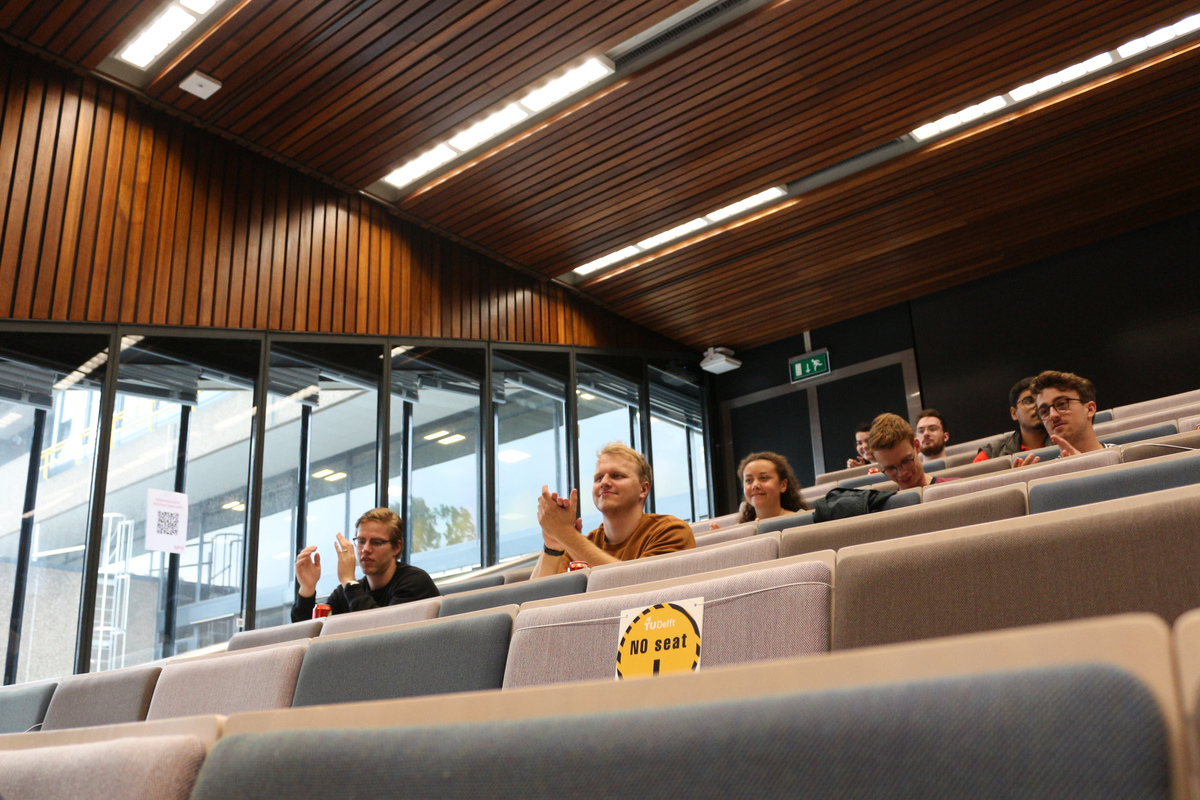In the fight against the coronavirus, TU Delft has brought the ventilation in all its buildings up to the required standard. But this alone is not enough.
On campus lectures have been resumed after the corona restrictions. (Photo: Justyna Botor)
With the flu season coming up, students are returning to lectures while the coronavirus is still spreading. Under these circumstances, how safe is it to sit in groups in lecture halls? And what about the aerosols – floating droplets that may contain the virus – for which we are warned?
Campus Real Estate (CRE) Director Jaco van Noppen explained that CRE used the time when the buildings were empty because of corona over the last year to bring the ventilation to the minimum standards required in the 2012 Building Code. The norm is 30 m3 of fresh air per person per hour. In older buildings such as Applied Physics, Civil Engineering and EEMCS, changes to the ventilation system were needed such as more capacity for the air supply and/or larger openings for the air vents. According to Van Noppen, there is currently no recirculation of air and all the air supplied comes from outside.
To check the effects of the ventilation system, the CO2 concentration in lecture halls is monitored. In newer buildings, the monitoring is part of the building management system. In other buildings, the monitoring is done randomly. The CO2 concentration is a measure of the proportion of fresh air supply and the number of people present. Van Noppen took these precautions after conferring with indoor climate specialists from the Faculty of Architecture and the Built Environment, Prof. Philo Bluyssen (Indoor Environment) and Prof. Atze Boerstra (Building Services Innovation).
Aerosols
Bluyssen was one of hundreds of researchers who signed an open letter to the World Health Organization (WHO) stating that the current ventilation guidelines were inadequate in stopping the spread of corona. The researchers were particularly concerned about the virus spreading through microscopic floating droplets (aerosols). “The Building Code was not designed to prevent the transmission of infectious diseases. It is intended to provide minimum ventilation. And this is not enough to ensure public health,” Bluyssen explained at the time to Delta.
When Delta checked back with her about the steps taken by CRE six months later, she said that the concentration of aerosols in the air cannot be measured unfortunately, let alone that there is a standard for it. ‘We are working on finding a method to measure or predict the amount of ventilation needed in relation to aerosols,’ she wrote. ‘At present, measuring the CO2 concentration is the only way to have an indication of the amount of air that is refreshed in rooms and spaces containing a lot of people.’
Recirculation
Boerstra says that the ventilation sector has little to work with given that even the WHO has still not determined a definitive norm to prevent infection through aerosols. Instead, it issues advice and guidelines that only say that the more ventilation the better, and preferably with 100% outside air.
But he also knows that the recirculation of ventilation air is unavoidable in winter in older buildings. These buildings do not have units that extract heat from air being transported outside. Boerstra says that “The trick is to avoid having the percentage of recirculation too high, but at 50% at the most for example. On top of that, you still need to supply 30 m3 of fresh air supply per person per hour. This is then 60 m3 of air supply, of which half is outside air.”
Infected person
At the same time, Boerstra explains that the 30 m3 fresh air per person per hour standard does not need to be taken too literally as there are other factors at play. “It’s always a combination of things. You can limit spreading through ventilation, but it is also important to tackle things at source. Minimise the chance that there is an infectious person in the lecture hall.” He points to the TU Delft Code of Conduct that was compiled for students for this purpose.
Do you want to know more?
- Ventilation standard: The RIVM (Netherlands National Institute for Public Health and the Environment) refers (in Dutch) to the Building Code for ventilation guidelines.The Building Code (in Dutch) requirement covers meeting rooms and requires a fresh air supply of at least 14.4 m3 per person per hour (3,600 x 4 litres/second). CRE upholds double this quantity: 30 m3 of fresh air per person per hour. Then there are the corona guidelines of the European ventilation sector, the REHVA.
- What does the CO2 concentration say? The CO2 concentration in ventilated spaces must preferably be below the 1,000 ppm (parts per million). The CO2 concentration outside is 400 ppm. If the concentration indoors is 1,500 ppm or more, there is often a musty smell in the room. This is a sign of polluted air as CO2 has no scent.
- CO2 meters are available for sale for a few dozens of euros and they show the air quality. At present, the smallest meters are only the size of a box of peppermints. Boerstra does not rule out that if meters continue being made ever smaller that CO2 and particulate matter meters will eventually be incorporated into smartwatches.
Do you have a question or comment about this article?
j.w.wassink@tudelft.nl


Comments are closed.